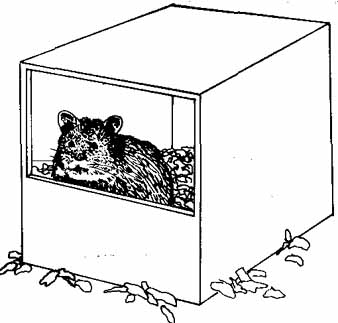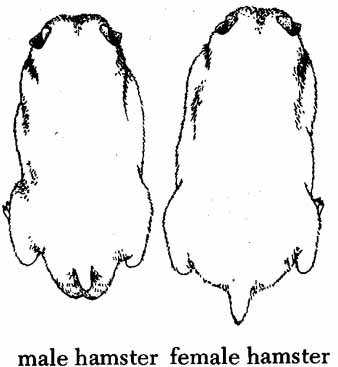Closely related as they may be, the small rodents and guinea pigs vary quite widely both in the frequency with which they have litters and in the number born. While the guinea pig bears from two to three litters annually, with between one and four in each, the prolific mouse is producing twice as many litters of four to ten young. Rats may have as many as seven litters annually, averaging eight to ten births each but ranging as high as fourteen. It has been estimated that, under ideal conditions, one pair of rats could have as many as twenty million descendants in only three years. Gerbil litters contain one to twelve and hamsters eight to ten young.
Survival among the small rodents, targets for so many predators, both afoot and airborne, depends on speed of reproduction and these animals waste little time getting about it.
Only six weeks after her birth, the female hamster is ready to mate, out stripping even the mouse by at least two weeks. Rats reach breeding age at three months. Gerbils come of age between ten (males) and twelve (females) weeks and guinea pigs, while capable of conceiving at one month, are best not mated until they are a half year old.
Mating the animals is a fairly simple procedure: with mice and rats no more than putting males and females together in the cage is needed. They then form their family units and construct the nests in which they will raise their lifters. With the gerbils, there is much more a question of self-determi nation. Putting a pair of opposite sexes together may accomplish nothing if they fail to take to each other. It is far wiser to try putting several of each sex in a cage, letting them pair off, and then isolating each couple while they go about building a family.
The fact that hamsters are not so particular does not mean that all will automatically go well once they have been introduced. Quite often, rather than turning to the pressing business of mating, the two will apparently find each other not only uninteresting but enemies at first sight. This does not mean that they will not later get together successfully. The battlers should be separated for a couple of days and a second female put in with the male. Breeders sometimes arrange mass matings, a number of males and twice as many females being placed in one cage. When all the females have been mated, they are removed and placed in breeding cages to bear and rear their young.
The harem system of mating can also be used with guinea pigs. A single male may be used with as many as six females.
PREGNANCY
Female hamsters have an incredibly brief gestation period, giving birth a mere i6 days after mating. Mice gestate for 20 days, rats take 21 to 23 days, gerbils 24, and guinea pigs 68. A further factor in the quick rate of reproduction among these animals is the rapidity with which they mate again. Within one day after delivering a lifter, the female guinea pig is willing to accept a male again. The gerbil will mate while nursing, gestating one lifter while bringing an earlier one to weaning.
The rodents, in general, require little special attention during pregnancy — though as she nears term, you might wish to give your female guinea pig a diet supplement of bread that has been soaked in milk, fresh or diluted condensed. Actually, the wisest course is to leave the prospective mother, of whatever species, alone as completely as is possible. Nervous mother hamsters often abort or kill their young. Try not to disturb a hamster’s nest for nine days after the young are born.
NESTS
Mice, rats, and gerbils will construct their own nests, given the materials, in which the litters will be born and reared; hamsters and guinea pigs, though, may be provided with nesting boxes, Each hamster can have a box, approximately 6 by 6 by 6 inches; place some of the nesting material within it and the rest anywhere in the cage. There should be an opening for the mother to enter and leave. The guinea pig’s nest should be just large enough for her and her lifter to be comfortable. Nesting boxes should be placed so that they will be exposed to neither drafts nor dampness.
Because of the possibility that under stress the mother might destroy her young, every effort should be made to assure her total privacy until she cares to venture out of the nest herself. Aside from this, rodents are excellent mothers and, experts in their role, should be left to it without human interference. Most rodent fathers — except hamsters — will either help to care for or not interfere with the young; male hamsters can become aggressive, though, and should be kept in a separate cage. The young should have as little contact with humans as possible, until they have reached a point of maturity where they leave the nest themselves.

LACTATION
Weaning takes place in an amazingly short time, in comparison with most mammals. Young mice are completely converted to an adult diet in only 21 days, gerbils at about the same lime, and hamsters in 25 days. Guinea pigs and rats nurse their young until they are three weeks old, though guinea pigs can be weaned earlier.
SEPARATING
To prevent overcrowding, indiscriminate breeding, and the combativeness of males as they reach sexual maturity, the young animals should be re moved from the cage and either sold, given away, or established in new colonies when they have been weaned.

male hamster; female hamster
SEXING
Determining the sex of rodents is not difficult if you know what to look for. In males, a penis can be protruded from the prepuce, and testicles can be felt either in a scrotal sac or under the skin in the groin area. Males have only two external openings in the groin: the anus, and a urethral opening at the lip of the penis. Females have three: anus, vagina, and a urethral opening at the lip of a small papilla like structure (or a small urethral protuberance). An additional way to judge the sex of hamsters is to view them from above: those with rounded rumps are female and those with pointed stems are male.
Suggested Readings
ROBINSON, D. G., JR. How to Raise and Train Gerbils. Neptune, New Jersey, TFH Publication 1967.
VILLIARD, P. Raising Small Animals for Fun and Profit. New York, Winchester Press, 1973.
Next: Squirrels
and Chipmunks
Prev.: Small
Rodents:
External and Internal Parasites & Disease